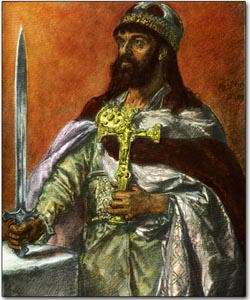Related Research Articles
The 800s decade ran from January 1, 800, to December 31, 809.
The 810s decade ran from January 1, 810, to December 31, 819.
The 830s decade ran from January 1, 830, to December 31, 839.
The 880s decade ran from January 1, 880, to December 31, 889.
The 900s decade ran from January 1, 900, to December 31, 909.
The 910s decade ran from January 1, 910, to December 31, 919.
The 940s decade ran from January 1, 940, to December 31, 949.
The 950s decade ran from January 1, 950, to December 31, 959.
The 970s decade ran from January 1, 970, to December 31, 979.
The 980s decade ran from January 1, 980, to December 31, 989.
The 990s decade ran from January 1, 990, to December 31, 999.

Year 967 (CMLXVII) was a common year starting on Tuesday of the Julian calendar.

Year 966 (CMLXVI) was a common year starting on Monday of the Julian calendar.

Year 961 (CMLXI) was a common year starting on Tuesday of the Julian calendar.

Year 962 (CMLXII) was a common year starting on Wednesday of the Julian calendar.

Year 963 (CMLXIII) was a common year starting on Thursday of the Julian calendar.

Year 968 (CMLXVIII) was a leap year starting on Wednesday of the Julian calendar.

Year 965 (CMLXV) was a common year starting on Sunday of the Julian calendar.

Year 960 (CMLX) was a leap year starting on Sunday of the Julian calendar.

Year 956 (CMLVI) was a leap year starting on Tuesday of the Julian calendar.
References
- ↑ Romane, Julian (2015). Byzantium Triumphant. Barnsley: Pen and Sword Books. p. 5. ISBN 978-1473845701.
- ↑ Richard Brzezinski (1998). History of Poland: Old Poland, King Mieszko I, p. 14. ISBN 83-7212-019-6.
- ↑ Romane, Julian (2015). Byzantine Triumphant. Barnsley: Pen and Sword Books. p. 6. ISBN 978-1473845701.
- ↑ Manuk-Khaloyan, Armen (2013). "In the Cemetery of their Ancestors: The Royal Burial Tombs of the Bagratuni Kings of Greater Armenia (890–1073/79)". Revue des Études Arméniennes : pp. 147–155.
- ↑ Chisholm, Hugh (1911). "Tavistock". Encyclopædia Britannica (Eleventh Edition). Cambridge University Press, pp. 457–458.
- ↑ Timothy Reuter (1999). The New Cambridge Medieval History, Volume III, p. 251. ISBN 978-0-521-36447-8.
- ↑ Timothy Reuter (1999). The New Cambridge Medieval History, Volume III, p. 592. ISBN 978-0-521-36447-8.
- ↑ Ostrogorsky, George (1969). History of The Byzantine State . New Brunswick: Rutgers University Press. p. 284. ISBN 0-8135-0599-2.
- ↑ Timothy Reuter (1999). The New Cambridge Medieval History, Volume III, p. 248. ISBN 978-0-521-36447-8.
- ↑ W. Treadgold. A History of the Byzantine State and Society, p. 948.
- ↑ W. Treadgold. A History of the Byzantine state and Society, p. 948.
- ↑ Jim Bradbury (2007). The Capetians: Kings of France, 987–1328, p. 43 (London: Hambledon Continuum).
- ↑ Richard Brzezinski (1998). History of Poland: Old Poland, King Mieszko I, p. 15. ISBN 83-7212-019-6.
- ↑ Jim Bradbury (2007). The Capetians: Kings of France, 987–1328, p. 42 (London: Hambledon Continuum).
- ↑ Richard Brzezinski (1998). History of Poland: Old Poland, King Mieszko I, p. 15. ISBN 83-7212-019-6.
- ↑ Bóna, Istvá (2000). The Hungarians and Europe in the 9th-10th centuries. Budapest: Historia - MTA Történettudományi Intézete, p. 34. ISBN 963-8312-67-X.
- ↑ Steven Runciman (1987). A History of the Crusades, Vol. 1. The First Crusade, p. 30 (Cambridge University Press).
- ↑ The Papacy: An Encyclopedia, Ed. Philippe Levillain, p. 841 (Routledge, 2002).
- ↑ W. Treadgold. A History of the Byzantine State and Society, p. 509.
- ↑ Reuter, Timothy (1991). Germany in the Early Middle Ages: 800–1056. Addison Wesley Longman. ISBN 978-0-582-49034-5.
- ↑ "The Abbey Church of St. Mary & St. Aethelfla". Archived from the original on June 19, 2016. Retrieved October 17, 2017.
- ↑ Fine, John V. A. Jr. (1991) [1983]. The Early Medieval Balkans: A Critical Survey from the Sixth to the Late Twelfth Century. Ann Arbor, Michigan: University of Michigan Press. p. 183. ISBN 0-472-08149-7.
- ↑ Reuter, Timothy (1999). The New Cambridge Medieval History, Volume III, p. 252. ISBN 978-0-521-36447-8.
- ↑ Reuter, Timothy (1999). The New Cambridge Medieval History, Volume III, p. 594. ISBN 978-0-521-36447-8.
- ↑ Fine, John V. A. Jr. (1991) [1983]. The Early Medieval Balkans: A Critical Survey from the Sixth to the Late Twelfth Century. Ann Arbor, Michigan: University of Michigan Press. p. 184. ISBN 0-472-08149-7..
- ↑ Reuter, Timothy (1999). The New Cambridge Medieval History, Volume III, p. 584. ISBN 978-0-521-36447-8.
- ↑ Gay, Jules (1904). L'Italie méridionale et l'empire Byzantin: Livre II. New York: Burt Franklin.
- ↑ The Fatimid Revolution (861-973) and its aftermath in North Africa, Michael Brett, The Cambridge History of Africa, Vol. 2 ed. J. D. Fage, Roland Anthony Oliver, (Cambridge University Press, 2002). p. 622.